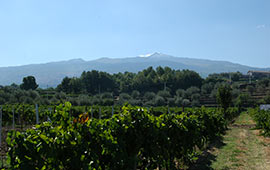The territory
“In 2002, the first year of production and bottling of the Tenuta delle Terre Nere, I wanted to define the Etna area – by somewhat daringly defining it on the back labels of the first bottles – the“ Burgundy of the Mediterranean ”. The juxtaposition between the far south of Europe (where Sicily is) and a distinctly Nordic “climate”, paradoxical at first sight, had its reasons. For Etna belongs to Sicily as the exception belongs to a rule, or as an island belongs to the sea. The weather on the slopes of Europe’s largest and very much alive volcano is unique in Sicily’s context. It simply stands alone. The high altitudes dedicated to viticulture start at 400 meters above sea level to reach over 1,000 meters (a variability unique in the world among the D.O.C.): they are characterized by temperature variations between day and night which in summer record up to 30 degrees. With extreme microclimatic differences. Equally extraordinary pedological differentiations are given by volcanic soils formed and reformed by lava flows following one another over the millennia of the volcano’s life, each flow a mineral reality in its own right. Soils of a very complex matrix that often emerge in veins of a very different nature a few hundred meters from each other. Apply all the above to that “belt” that is the Etna D.O.C., girdling a volcanic circumference of about 120 square kilometers, with exposures that range from full south to full north and everything in between. Then weave into the tapestry an average rainfall six to ten times that of the Sicilian norm, a relevant part of which occurs during by far the latest harvest in Sicily, and, indeed, one of the latest in Europe. Well, perhaps, then the paradoxical comparison to a Burgundy – justly famous for the multiplicity of its soils and the dangerously whimsical nature of its climate – may appear more acceptable. Where the analogy fascinates even further is in the character of the wines. It isn’t really a similarity in taste. Yet one powerfully feels they are siblings. Drinking them one is inescapably struck by a similarity that runs deep and binds. They have an effortless way about them, as if the same hand wove them. Refined fingers weaving deftly through soil and stone creating shade upon shade of chromatic and sensorial variations”.
Marco De Grazia





